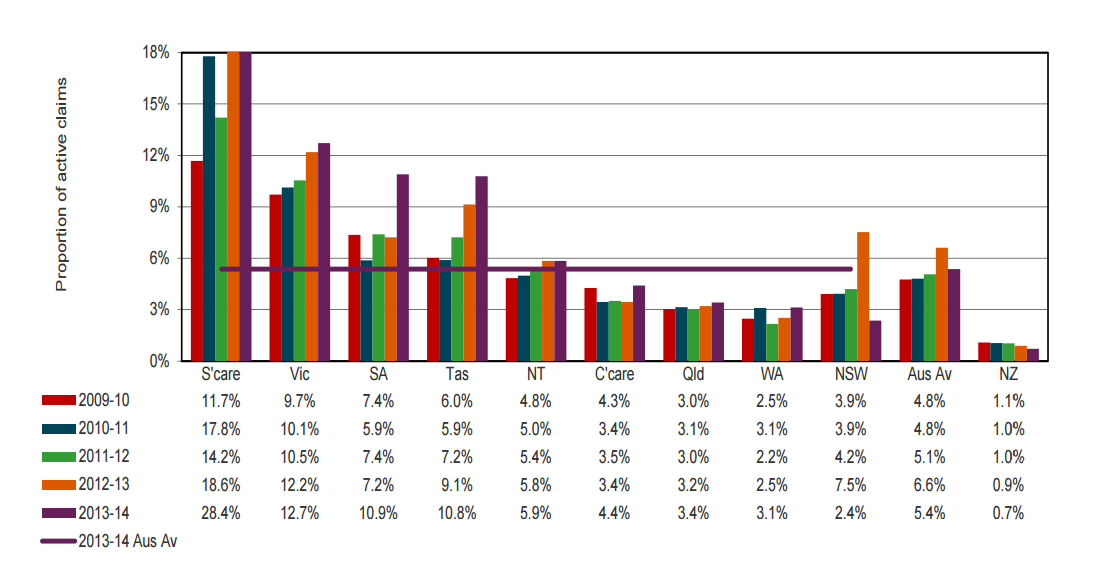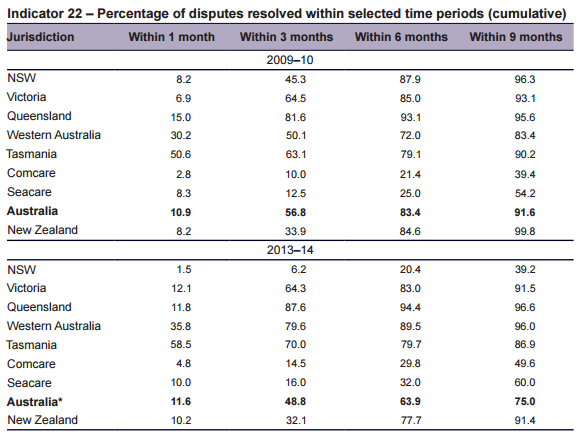Dispute Resolutions: How does your jurisdiction stack up?

The Comparative Performance Monitoring Report (CPM) studies various trends in workers compensation and work health & safety across the schemes operating in Australia and New Zealand. This article looks specifically at how the different jurisdictions are handling disputes.
Dispute Rates
Disputes in this context are appeals to a formal mechanism. They might include a review officer, or a conciliation or mediation service. The disputes tend to be against an insurer’s decision or other decisions relating to compensation. These disputes do not include common law claims, and do not include redemptions or commutations unless they were processed as disputes through the jurisdiction’s dispute resolution service.
Chart: Proportion of Active Claims with a Dispute across Australian Compensation Jurisdictions 2009-2014

Across all Australian claims the dispute rate per active claim increased by 37.5% between 2009 and 2013. With the exception of NSW, all jurisdictions recorded increases in the number of disputes. There are signs of improvement however. In 2013-2014, 5.4% of active claims in Australia were in dispute, down 18% on the previous year.
The highest proportions of disputes against an active claim were in Seacare, Victoria, South Australia and Tasmania. The lowest proportions were in Queensland, Western Australia, New South Wales and New Zealand.
It should be noted that:
- The increased disputation rate of 51% in South Australia in 2013-14 compared to the previous year has occurred after a major change in the South Australian system.
- The 2013-14 decrease of 68% in NSW compared to the previous year was the result of legislative change in 2012. This change led to an increase in applications for 10 months in 2012-13, and as a result there were substantial delays in the resolution of disputes.
- In 2013-14, Comcare recorded a disputation rate of 4.4%, a 29% increase on the previous year.
- The highest disputation rate was through Seacare, with 28.4% of active claims in dispute in 2013-14. During this time, 85 applications were lodged with the Administrative Appeals Tribunal, a 29% increase on the previous year. According to the review, “this indicates the propensity for seafarers and their representatives to seek a review of their claim.”
- The highest rate of disputes in the more usual jurisdictions (under Seacare workers need to be fit for their normal job before returning to work) is in Victoria, where disputes have been increasing year on year since 2009-10. Over that period there has not been major system change that accounts for the 31% increase in disputes.
- The increase in the rate of disputes in Tasmania is likely the result of legislative changes in 2010, which included the requirement that all settlements occurring within two years of the date of claim lodgement be referred to the tribunal for approval, and for all parties to notify the tribunal of a dispute with regard to injury management.
- The low dispute rate in New Zealand may in part relate to the structure in which the accident compensation scheme covers incidents at work, at home, on the road or playing sport. As a result, all are covered regardless of their earning status.
Dispute Resolution
The report noted that the simpler the process, the more likely that the dispute will be resolved quickly. Where there were delays in the collection, exchange and lodgement of information, it was likely that there would be increased costs and an increase in the adversarial nature of the disputes.
Disputes which were resolved over a longer time may mean there are more complex disputes being handled within a particular jurisdiction. There may also be mandatory legal or medical processes in place which need to be followed.
The table below shows the timeframe for resolving disputes across Australia and New Zealand. South Australia and Northern Territory did not supply data on dispute resolution times.

Some findings of note:
- In 2013-14, 49% of the disputes were resolved within three months from the date of lodgement across Australia, with Queensland on 88% and Western Australia on 80%. The WA results, variable across the months studied, were the result of compensation reforms in the state in December 2011.
- Comcare tended to take a longer time to resolve disputes than other jurisdictions. Disputes in this jurisdiction go to an independent, external body, and Comcare does not have control over the timeframes. The report also noted the complexity of the claims and the long resolution time required. The proportion of disputes which were resolved within the four time periods recorded large increases on previous years.
- Seacare also showed significant improvement in the proportion of disputes resolved in the timeframes, but the proportions for all of the time periods remained among the lowest in the jurisdictions. Many factors influence this, including the time needed by the parties to obtain evidence. As the jurisdiction is small, minor changes in case finalisation numbers at particular times can have a very high impact on the statistics.
- Tasmania’s dispute resolution service resolved 58% of claims within a month, a far higher proportion than any other jurisdiction. The proportion of disputes resolved in three, six and nine months was also higher than the Australian average. This may be because all settlements are included in their statistics.
- At the opposite end of the scale, NSW and Comcare resolved only 5% of disputes in one month. For NSW, this was likely the result of legislative change in June 2012, leading to an increase in applications to April 2013. This resulted in a significant increase in workload, and therefore significant delays. The number of applications in 2013-14 reduced to 46% of the pre-amendment average.
- The resolution times in NSW were also impacted by the requirement for a mandatory medical assessment in commission proceedings relating to disputes over permanent impairment entitlements. This area of compensation was subject to the highest number of disputes.
- Victorian resolution times were impacted by the compulsory conciliation service, which may include a medical panel referral. Court litigation may only occur once the compulsory conciliation service is completed.
The full CPM17 Report can be accessed here.

